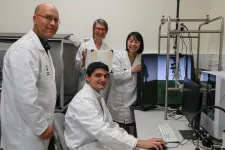Researchers show complex relationship between Arctic warming and Arctic dust
2024-11-26
(Press-News.org)
The Arctic is warming two to four times faster than the global average. A recent study by researchers in Japan found that dust from snow- and ice-free areas of the Arctic may be an important contributor to climate change in the region. The findings were published in the journal npj Climate and Atmospheric Science.
According to one view, higher temperatures in the Arctic are thought to lead to the region's clouds containing more liquid droplets and fewer ice crystals. Clouds become thicker, longer lasting, and more likely to reflect sunlight. As a result, this might cool the region during summer (temperature feedback).
However, the new study showed that as the Arctic warms, snow- and ice-free areas increase, leading to an increase in dust emissions. The dust promotes the formation of ice crystals in the clouds. It is possible that more ice crystals in the clouds are making the clouds thinner and shorter-lived, thus reflecting less sunlight, which might heat the region during summer (emission feedback).
"Increasing amounts of dust due to Arctic warming may cause the opposite phenomenon of the conventional understanding of ice crystal changes," said Associate Professor Hitoshi Matsui of Nagoya University, the lead author of the study. "Our previous study found that a large amount of Arctic dust is distributed in the lower troposphere (below about 3 km altitude) over the region in summer and early fall, with the dust acting as a very efficient nucleus for ice formation in clouds at this altitude during the season."
To estimate the impact of Arctic dust on the clouds of the region, Matsui and Dr. Kei Kawai of Nagoya University, in collaboration with researchers from the National Institute of Polar Research and Hokkaido University, conducted a study using the CAM-ATRAS global aerosol-climate model.
They first looked at changes in the amount of dust released from the Arctic land surface over the past 40 years, between 1981 and 2020. The simulations showed that dust emissions increased by 20% during this period as the Arctic warmed. This increase promotes ice nucleation in clouds in the lower troposphere, weakening the efficiency of clouds to contain more liquid droplets and fewer ice crystals as the Arctic warms. Increased dust levels promote ice crystal formation, outweighing the decrease in ice crystal formation by the temperature feedback in 30% of the region annually and 70% in summer.
"Most climate models have not considered the effects of dust from the Arctic land surface," Matsui said. "Our research suggests that the counterbalancing temperature and emission feedbacks should be considered to improve the accuracy of climate change predictions in the Arctic."
END
ELSE PRESS RELEASES FROM THIS DATE:
2024-11-26
Researchers from the University of Gothenburg are the first to prove that painful stimuli are sent to the brain of shore crabs providing more evidence for pain in crustaceans. EEG style measurements show clear neural reactions in the crustacean's brain during mechanical or chemical stimulation.
In the search for a better welfare of animals that we humans kill for food, researchers at the University of Gothenburg have chosen to focus on decapod crustaceans. This includes shellfish delicacies such as prawns, lobsters, crabs and crayfish that we both catch wild and farm. Currently, ...
2024-11-26
Social stress is bad for your brain. It’s a prime suspect in the accumulation of oxidative stress in the brain, which is believed to contribute to mental health and neurodegenerative disorders — but the mechanisms that turn social stress into oxidative stress, and how social status affects this, are poorly understood. By studying a highly social, very hierarchical fish species, cichlids, scientists have now found that social stress raises oxidative stress in the brains of low-status fish.
“We found that low rank was generally linked to higher levels of oxidative stress in the brain,” said Dr Peter Dijkstra of ...
2024-11-26
Due to the growing reality of global warming and climate change, there is increasing uncertainty around meteorological conditions used in energy assessments of buildings. Existing methods for generating meteorological data do not adequately handle the interdependence of meteorological elements, such as solar radiation, air temperature, and absolute humidity, which are important for calculating energy usage and efficiency.
To address this challenge, a research team at Osaka Metropolitan University’s Graduate School of Human Life and Ecology—comprising Associate ...
2024-11-26
Humans get a real buzz from the virtual world of gaming and augmented reality but now scientists have trialled the use of these new-age technologies on small animals, to test the reactions of tiny hoverflies and even crabs.
In a bid to comprehend the aerodynamic powers of flying insects and other little-understood animal behaviours, the Flinders University-led study is gaining new perspectives on how invertebrates respond to, interact with and navigate virtual ‘worlds’ created by advanced entertainment technology.
Published in the ...
2024-11-26
Three years after bulk carrier MV Wakashio ran aground on a coral reef off Mauritius, spilling 1000 tonnes of a new type of marine fuel oil, Curtin University-led research has confirmed the oil is still present in an environmentally sensitive mangrove forest close to important Ramsar conservation sites.
Lead researcher Dr Alan Scarlett, from Curtin’s WA Organic and Isotope Geochemistry Centre in the School of Earth and Planetary Sciences, said the chemical ‘fingerprint’ of the oil found ...
2024-11-26
Researchers are calling for a formal process that recognises and acknowledges the invaluable contributions of those with lived experience in healthcare research.
New research by Flinders University published in the Patient Education and Counselling journal exposes underlying issues in academic engagement and calls for better processes to credit those with lived experiences.
“With the growing awareness of the importance of diversity and inclusion in research, it is time for the research community to monitor not only how often, but also how well people with lived experience are involved,” says Associate Professor Elizabeth Lynch.
Associate Professor Lynch from the College of ...
2024-11-26
Despite a heavy infusion of public and private support during the COVID-19 pandemic, Medicaid and Medicare beneficiaries in Oregon reported that housing and food insecurity shot up during the onset of the pandemic in March of 2020 — and their basic needs remained in doubt through at least the end of the following year.
The survey data were reported in a study led by Oregon Health & Science University and published today in the Annals of Family Medicine.
The Oregon study provides a state-specific dimension to a nationwide survey ...
2024-11-26
Min Li, Ph.D., a George Lynn Cross Professor of Medicine, Surgery and Cell Biology at the University of Oklahoma College of Medicine and Associate Director for Global Oncology at OU Health Stephenson Cancer Center, will receive the 2024 Palade Prize from the International Association of Pancreatology.
The Palade Prize, the IAP’s most distinguished award for research excellence, recognizes Li’s contributions to the field of pancreatology, which is dedicated to discovering new methods of identifying, diagnosing and treating diseases of the pancreas such as pancreatic ...
2024-11-26
**Embargo: 23.30 [UK time], 6:30 p.m. [ET], 3:30 p.m. [PT], Monday, November 25 2024**
In contrast, the percentage of the population without a suppressed level of HIV (PUV) increased by 116.1% in Central Europe, Eastern Europe, and Central Asia from 2003 to 2021.
The study authors are issuing recommendations to invigorate the global HIV response across global public health programs dedicated to HIV control and expansion of prevention services.
The Institute for Health Metrics and Evaluation (IHME) has published a new study in The Lancet HIV journal that revealed significant progress in the global fight against HIV/AIDS, alongside ...
2024-11-26
The biggest and most comprehensive analysis of glucagon-like peptide-1 (GLP-1) receptor agonists on kidney and cardiovascular outcomes shows they have significant benefits in people with and without diabetes.1 Findings were published today in The Lancet Diabetes & Endocrinology.
Originally developed to treat diabetes, GLP-1 receptor agonists mimic the action of a hormone called glucagon-like peptide 1, which stimulates insulin production and lowers blood sugar levels. More recently, they have emerged as effective treatments for obesity - slowing digestion, ...
LAST 30 PRESS RELEASES:
[Press-News.org] Researchers show complex relationship between Arctic warming and Arctic dust







